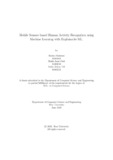| dc.contributor.advisor | Rahman, Md. Khalilur | |
| dc.contributor.advisor | Alam, Md. Golam Rabiul | |
| dc.contributor.author | Rahman, Raihan | |
| dc.contributor.author | Osdi, Shafin Jami | |
| dc.contributor.author | Till, Sadia Sidran | |
| dc.date.accessioned | 2021-09-03T05:30:45Z | |
| dc.date.available | 2021-09-03T05:30:45Z | |
| dc.date.copyright | 2021 | |
| dc.date.issued | 2021 | |
| dc.identifier.other | ID 16301201 | |
| dc.identifier.other | ID 14301048 | |
| dc.identifier.other | ID 16301211 | |
| dc.identifier.uri | http://hdl.handle.net/10361/14963 | |
| dc.description | This thesis is submitted in partial fulfillment of the requirements for the degree of Bachelor of Science in Computer Science and Engineering, 2021. | en_US |
| dc.description | Cataloged from PDF version of thesis. | |
| dc.description | Includes bibliographical references (33-34). | |
| dc.description.abstract | Based on the data collected from the sensors of smartphone a region that has garnered a lot of interest has a consequence of the growing popularity in the numerous
variety for pertaining to applications(i.e. Real world implementations), of ambient intelligence, such of which includes from health care and sports to surveillance
and even remote healthcare monitoring, is known to be HAR(i.e. Which stands
for Human Activity Recognition). MThere are numerous studies that have, unraveled astounding discoveries upon the use of a diverse array of different sensors of
contemporary smartphones in this context (examples of such sensors includes accelerometer, gyroscope etc). Despite the fact that there is a behaviour which is the
same sensor motion wave form is varied to significant extent in a large number of
enhanced mobile phone (i.e. smartphone), position. As a result the comprehension
of actions to vast range would be strenuous to do with high accuracy and precision. Each of every distinct person their patterns of movements in comparison to
one another substantially and recognizably vary. These are due to various different
relevant parameters of assessments related to the analysis which includes each individual’s gender, age, age band and behavioural habits, and their professions the
diet, life style the region they live in which exacerbates the challenge of defining
the boundaries of distinct activities. . 563 features were train and tested through
supervised machine learning approach. Among the algorithms SVM came up with
the highest number of accuracy. In our work we tried to bring the explainability
of a machine learning model through LIME and SHAPE. We used SVM model for
applying LIME and used SHAPE for Deep Neural Network. This two approach
helped us to understand which features are the key features, how they changed and
which features will be more effective. | en_US |
| dc.description.statementofresponsibility | Raihan Rahman | |
| dc.description.statementofresponsibility | Shafin Jami Osdi | |
| dc.description.statementofresponsibility | Sadia Sidran Till | |
| dc.format.extent | 34 pages | |
| dc.language.iso | en | en_US |
| dc.publisher | Brac University | en_US |
| dc.rights | Brac University theses are protected by copyright. They may be viewed from this source for any purpose, but reproduction or distribution in any format is prohibited without written permission. | |
| dc.subject | SHAPE (SHapley Additive exPlanation) | en_US |
| dc.subject | Machine Learning | en_US |
| dc.subject | LIME (Local Interpretable Model-Agnostic Explanations) | en_US |
| dc.subject | Neural Network | |
| dc.subject | Explainable ML | |
| dc.subject.lcsh | Machine learning. | |
| dc.title | Mobile sensors based human activity recognition using machine learning with explainable ML | en_US |
| dc.type | Thesis | en_US |
| dc.contributor.department | Department of Computer Science and Engineering, Brac University | |
| dc.description.degree | B. Computer Science | |

